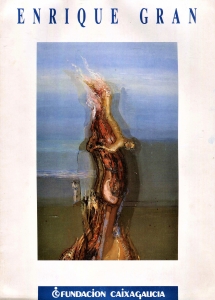ENRIQUE GRAN-LEOPOLDO RODRÍGUEZ ALCALDE (1990)
Exhibition organised by the Caixa Galicia Foundation. La Coruña
Enrique Gran exhibits from time to time. He shows no haste, no ambition, no greediness. And when, after a period of silence, he grants us the privilege of an exhibition, he never ceases to surprise us. Surprises that arise from the noble evidence of the recent originality that is emerging and from the fidelity to an inspiration presided over by unity of feeling. There are no abrupt cuts, no stormy turns; and yet his planet of fascinating visions shows, in the frame of his images, new penetrations of dreams, new predilections of colour.
Here we have, before the gaze that does not forget and that wishes, those perspectives, that extend towards a sea that we feel infinite or on surfaces also deserted or moors. Great spaces of land and sky, of a land and sky that we do not know where their respective limits are, that unfold as “times” of an unembraceable symphony from which all the echoes of human voices are banished: rhythms of matter and rhythms of colour structure these vast compositions that are contemporized in a phantasmagoric impression, behind which we guess or verify a rigour of thought, a demanding sense of construction, where nothing is volatile, where there is no excess of improvisation or the superfluous. We have already alluded to the unity of intention in Enrique Gran’s work: now we insist on the absolute sensation of harmony that prevails in each canvas.
We can believe that those unembraceable extensions and those close-ups that we cannot fully define come from the gigantic, and never ordered, machine of dreams. We can believe that that pictorial universe is populated by ghosts, ghosts that, by the way, do not come from the human being but from fantastic objects: metallic masses, distillations of fire, fragments of waste that have not arisen from a delirium, have been generated by a firm purpose of creation. Enrique Gran’s landscape does not belong to a chaotic universe, even though we have been able to intuit it through so many dazzles of freedom: the tremors and the flickering cover up statements, severe roots of a work that does not stop in its conscious search for colour, matter, plastic harmony, everything that contributes to make a canvas a permanent lesson and a lasting impression.
And the painting of Enrique Gran always provides, thanks to that firmness of conception, the rubric of the grandiose. We admire those panoramas of immense sea, on whose shores rise shells of a thousand colours, shells of unimaginable depths, snakes of vivid tones that those who contemplate them cannot identify, but which have arisen from an intention or an enthusiasm of those hands, of those brushes that lavish strange stones, wisely combined in the indecipherable images that stand out in the foreground of the large canvases, chimerical protagonists, well organised in the mind of an artist who knows how to coordinate his dreams into a vigorous realisation.
For a long time we have been witnesses -and with much attention, with much enthusiasm- of Enrique Gran’s displays of imagination:
We have lived, at some point, within those night visions of beaches that we knew were real and created; we have submerged ourselves in the sands presided over by majestic conches or by rocky outcrops that suggested to us the presence of an unknown kingdom, which precisely because it was ignored exercised over us the maximum capacity of suggestion. We continue to hit these materialisations of the creative imagination, which are at the same time, and above all, magnificent pieces of painting, sumptuous displays of a courageous and reflective composition. Enrique Gran extends the colour in homogeneous surfaces that majestically cover the background of the canvas, always taking care to place, as protagonists of the creation, mysterious and burning volumes that sometimes suggest rocks or shells that emerge from a magic sandbox, or group very rich colour notes, proliferation of intense tonalities that the artist himself does not want to define; we are again before that free enjoyment of painting where the greatness of impressionism or abstraction was forged.
Enrique Gran’s painting continues to be unclassifiable if we strive to include it in movements or subversions. It is profoundly updated by the already mentioned cult of plastic splendour and by that invisible shudder of restlessness that runs through it, a restlessness of questioning, of the mystery that brings us all together and whose penetration enthuses Enrique. He tries to approach the secret of universal creation with the weapons of artistic creation, to which Enrique Gran owes his best hours, with the deep gratitude of those who admire his victorious struggle.
Leopoldo Rodríguez Alcalde
